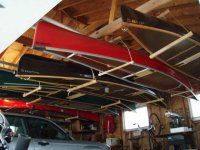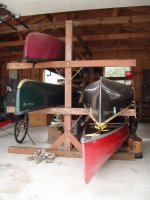I believe that the hull shape, especially the bottom shape, is the single biggest contributor to the tendency of some makes/models of poly canoes going hogback (or even go wavey-bottomed).
Flat bottomed hulls, like many of the poly Old Towns, are among the worst. Years ago on a visit to OT I saw dozens of new Discos already hogged at the factory, awaiting delivery. (To Old Town’s credit I think that model Disco was short lived)
...
Poly hulls with some bottom arch are much less prone to hogging. A poly canoe with some arch and rocker, like the old Nova Craft SP3 (now outfitter Prospector), will make for a much stiffer bottom and be far less prone to hogging or distortion.
...


